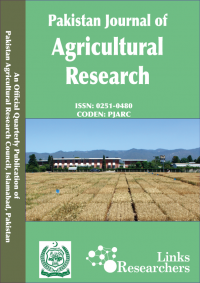ROLE OF HONEY BEES FORAGING ACTIVITIES IN INCREASED FRUIT SETTING AND PRODUCTION OF APPLES APIS MELLIFERA MALUS DOMESTICA
ABSTRACT
The study was executed at Murree Hills, Pakistan to evaluate the effect of honey bee ( ) foraging activities on number of apple fruits per panicle and enhancement of apple weight. Apple Ameri trees were applied with natural pollination (T ) , pollination by honey bees only (T ), natural pollination augmented with honey bees (T ) and no pollination (T ,control). There was a significant increase in the apple fruit setting and weight gain in pollinated plants compared to non-pollinated plants. Maximum number of fruits per panicle were 5.33±0.51(Mean±SE) whereas the highest fruit weight 170±2.65g (Mean±SE) was recorded in plants provided with augmentation of honey bees along with natural pollination. The lowest fruit weight of 80±3.05g (Mean±SE) and the minimum 0.33±0.19 (Mean±SE) fruits per panicle were observed in the plants with no pollination. There was 1515%, 406% and 909% percent increase in number of fruits per panicle in trees provided with different types of pollination viz., natural pollination plus honey bees augmentation (T ), plants pollinated with honey bees only (T ) and natural pollination treated plants (T ), respectively over the trees with no pollination. Similarly, the percent increase in apple weight gain over the control was recorded as 31%, 113% and 56% in trees provided with A. mellifera pollinated plants only (T ), plants naturally pollinated + augmentation of A. mellifera (T ) and plants having natural pollination (T ), respectively.
To share on other social networks, click on any share button. What are these?






